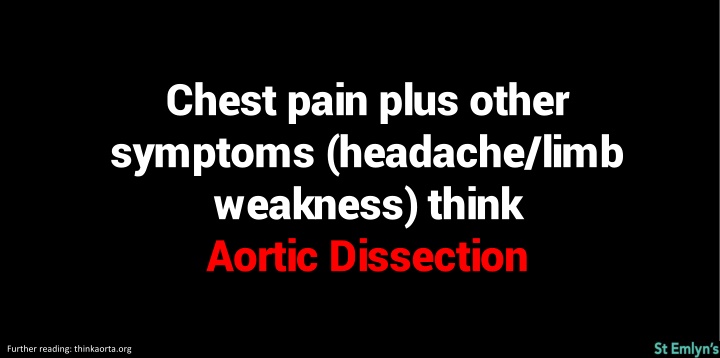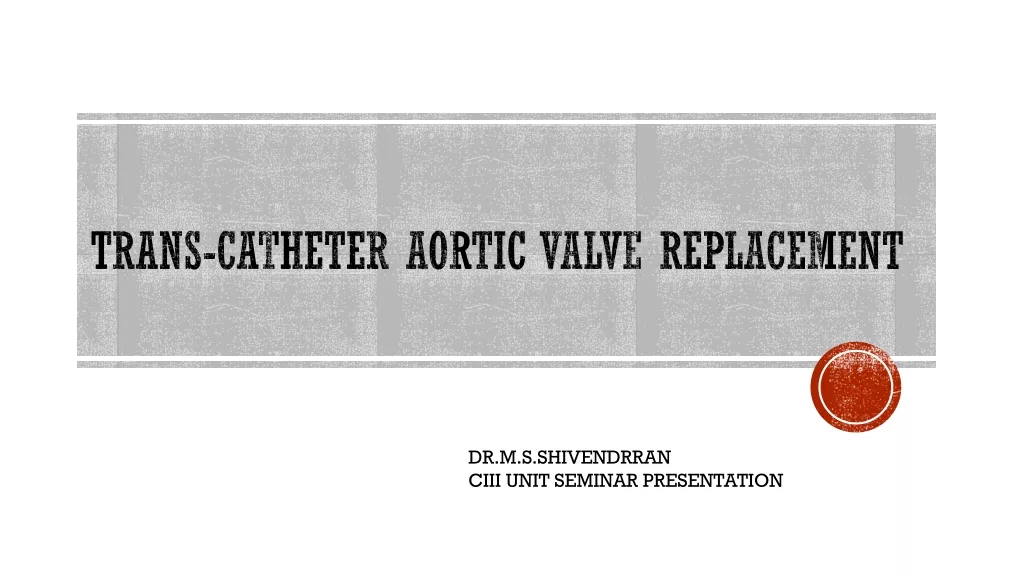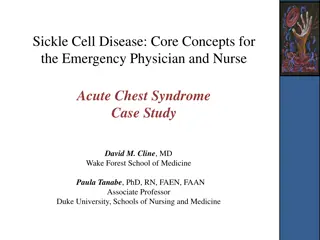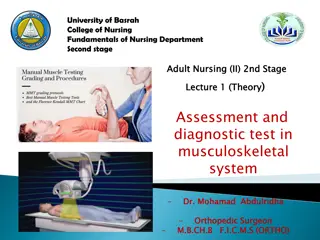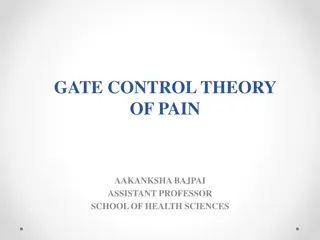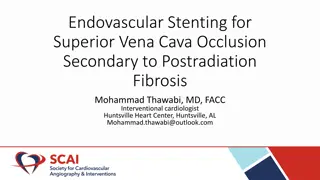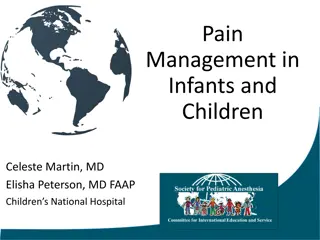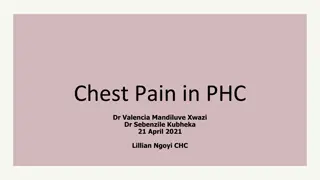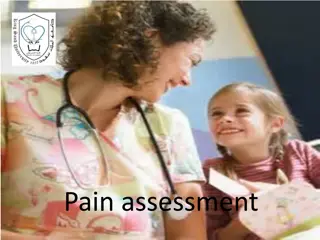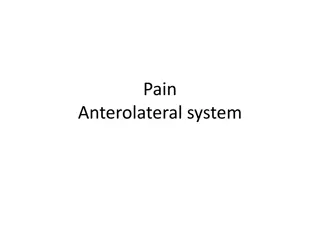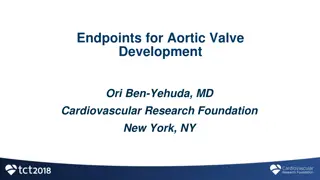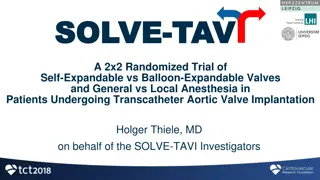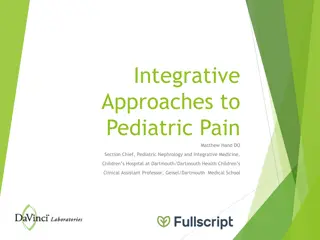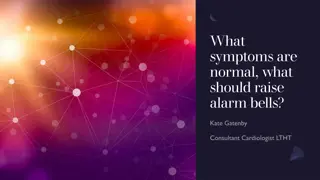Recognizing Aortic Dissection: Chest Pain & Other Symptoms
Chest pain accompanied by symptoms like headaches and limb weakness could indicate a serious condition like aortic dissection. Learn more about the top causes of chest pain and immediate considerations for patient care. Understand the role of troponin levels and ECG in ruling out acute coronary syndrome. Explore different pain relief options and be aware of conditions like ankylosing spondylitis and COVID-19 implications on cardiac health.
Download Presentation

Please find below an Image/Link to download the presentation.
The content on the website is provided AS IS for your information and personal use only. It may not be sold, licensed, or shared on other websites without obtaining consent from the author.If you encounter any issues during the download, it is possible that the publisher has removed the file from their server.
You are allowed to download the files provided on this website for personal or commercial use, subject to the condition that they are used lawfully. All files are the property of their respective owners.
The content on the website is provided AS IS for your information and personal use only. It may not be sold, licensed, or shared on other websites without obtaining consent from the author.
E N D
Presentation Transcript
Chest pain plus other symptoms (headache/limb weakness) think Aortic Dissection Further reading: thinkaorta.org
Top Five Causes of Chest pain to rule out ACS PE Aortic dissection Pnuemothorax Pneumonia Further reading: www.stemlynsblog.org/induction-chest-pain/
Two high sensitivity troponins below the 99th Centile (cut-off) and a normal ECG and the patient is very unlikely to have ACS Further reading: www.stemlynsblog.org/jc-are-we-fully-loded/
Three Immediate Considerations: Does your patient need resuscitation? Does your patient need pain relief? Does your patient need admission?
Pain relief: Mild Paracetamol/NSAIDs Moderate as mild plus dihydrocodiene Severe morphine
Pain relief: Morphine is three times more potent than oramorph (10mg iv morphine = 30mg oramorph)
Collapse ?cause is not a diagnosis Further reading: www.stemlynsblog.org/induction-syncope/
Female patient between 10 and 60 with abdominal pain do a pregnancy test Further reading: www.stemlynsblog.org/problems-early-pregnancy-induction/
Ankylosing spondylitis and neck trauma = fracture until proven otherwise (bamboo spine)
COVID-19 can cause raised troponin for lots of reasons think ACS first then ?myocarditis Further reading: ww.stemlynsblog.org/covid-19-and-the-heart-st-emlyns/
Top Five Causes of Shortness of breath to rule out PE Asthma / COPD Acute LVF Pnuemothorax Pneumonia Further reading: www.stemlynsblog.org/induction-breathless//
Always consider four treatments Oxygen Analgesia Fluids Antibiotics Further reading: wwww.stemlynsblog.org/induction-introduction/
The Sepsis Six Oxygen (to sats of 94%) Take blood cultures and consider source control Give antibiotics Measure lactate Start intravenous fluids Insert urinary catheter Further reading: www.rcem.ac.uk/docs/Sepsis/Sepsis%20Toolkit.pdf
Check triage ECGs carefully for Any ST elevation Any ST depression Any arrthymia And act on abnormalities
In Syncope Cerebral perfusion pressure HR x SV x SVR Further reading: www.stemlynsblog.org/induction-syncope/
Blood tests rarely make a difference to whether the patient needs admission
If a patient has a positive high sensitivity troponin consider all possible causes Further reading: www.stemlynsblog.org/cardiac-troponin-basics-st-emlyns/
Potential causes of raised anion acidosis CO / Cyanide Alcoholic ketoacidosis Toluene Methanol Isoniazid Uraemia Lactate DKA Ethanol Paraldehyde Salicylates
Older patient with syncope? Think AAA Further reading: thinkaorta.org/
Red Flags in Back Pain: Age <19 or >55 Associated weight loss Known cancer Night sweats ?Cauda altered sensation, disturbance of bladder/bowel function Further reading: www.stemlynsblog.org/back-to-basics-back-pain-in-the-ed/
>65 and symptoms of lower UTI? DO NOT dip the urine send for MC&S and start antibiotics according to Trust guidance Further reading: https://www.nice.org.uk/guidance/ng109/chapter/Recommendations
Red Flags in Vertigo: Acute onset not provoked by movement Headache or other neuro symptom Hearing loss Worsening symptoms Risk factors for cerebrovascular disease
Remember to examine the hip joint in patients with knee pain (and vice versa)
If a patient requires multiple naloxone boluses consider an infusion
If doing an ABG use lignocaine (they hurt!) Further reading: www.stemlynsblog.org/self-experimentation-medical-education-la-abgs/
If a previously ambulant patient is discharged and needs a wheelchair: Why can they no longer mobilise? Have we missed something? How will they manage at home?
Criteria for DKA: Diabetes Blood glucose>11 or a history of DM Ketones: >3mmol/l Acidosis: pH 7.3 or bicarbonate >15
Patients being discharged after an asthma exacerbation should be seen by their GP/asthma nurse within two days Further reading: brit-thoracic.org.uk/quality-improvement/guidelines/asthma/
Signs of Life Threatening Asthma: Silent chest Cyanosis Poor respiratory effort Hypotension Exhaustion Altered conscious level Arrthythmia Further reading: brit-thoracic.org.uk/quality-improvement/guidelines/asthma/
Signs of acute severe asthma: SpO2 <92% PEFR 33-50% best or predicted Heart rate >110/min Resp rate >25/min Unable to complete sentences in one breath Further reading: brit-thoracic.org.uk/quality-improvement/guidelines/asthma/
Give steroids in adequate doses in all episodes of acute asthma Further reading: brit-thoracic.org.uk/quality-improvement/guidelines/asthma/
Consider a dose of iv magnesium in all episodes of acute asthma (where no good response to initial treatment) Further reading: brit-thoracic.org.uk/quality-improvement/guidelines/asthma/
All non-shocked children with DKA should get a 10ml/kg bolus over 60 minutes Further reading: www.stemlynsblog.org/d-k-hooray-new-paeds-dka-guidelines/
DOACs can be used as interim anticoagulation pending diagnosis of ?VTE Further reading: www.stemlynsblog.org/nice-guidelines-vte/
Suspected Variceal bleeding give Terlipressin 2mg qds and antibiotics
Always document your results (including CXR) in the patient notes
First presentation of foot infection? Ask if they have diabetes and check blood glucose
Prescribing for children? Check the dose (using weight based dosing)
Unexplained Severe Pain? THINK AORTA Further reading: thinkaorta.org
After a Fascia Iliaca Block document site, side, dose and time of block Further reading: tinyurl.com/RCEMFIB
Do not stop insulin, antiepileptic or anti Parkinson drugs precipitously
Always check the patients details are correct before taking blood
Adult ALS CPR = 30:2 Further reading: https://www.resus.org.uk/resuscitation-guidelines/adult-advanced-life-support/
Adult ALS Give adrenaline every 3-5 mins Further reading: https://www.resus.org.uk/resuscitation-guidelines/adult-advanced-life-support/
